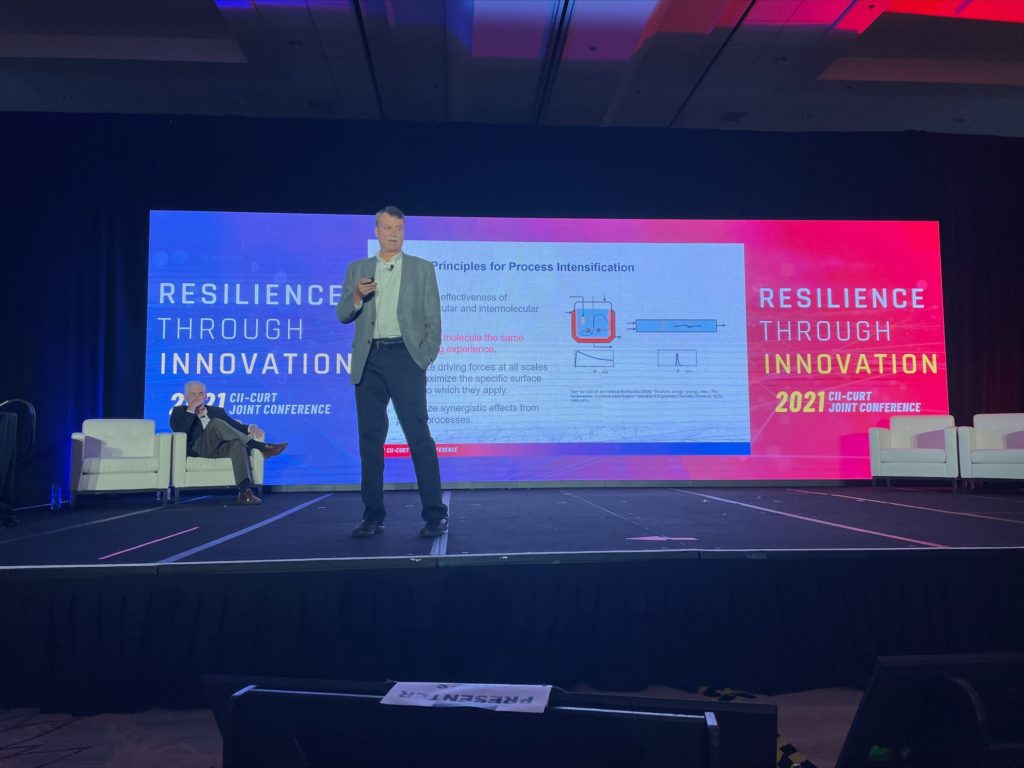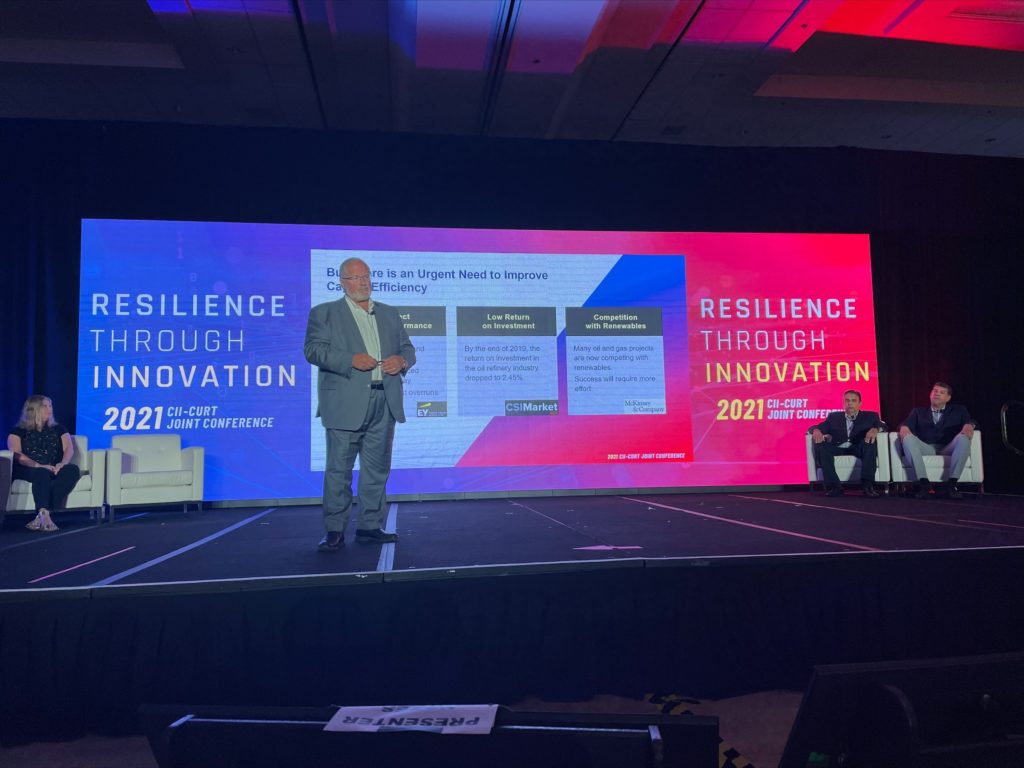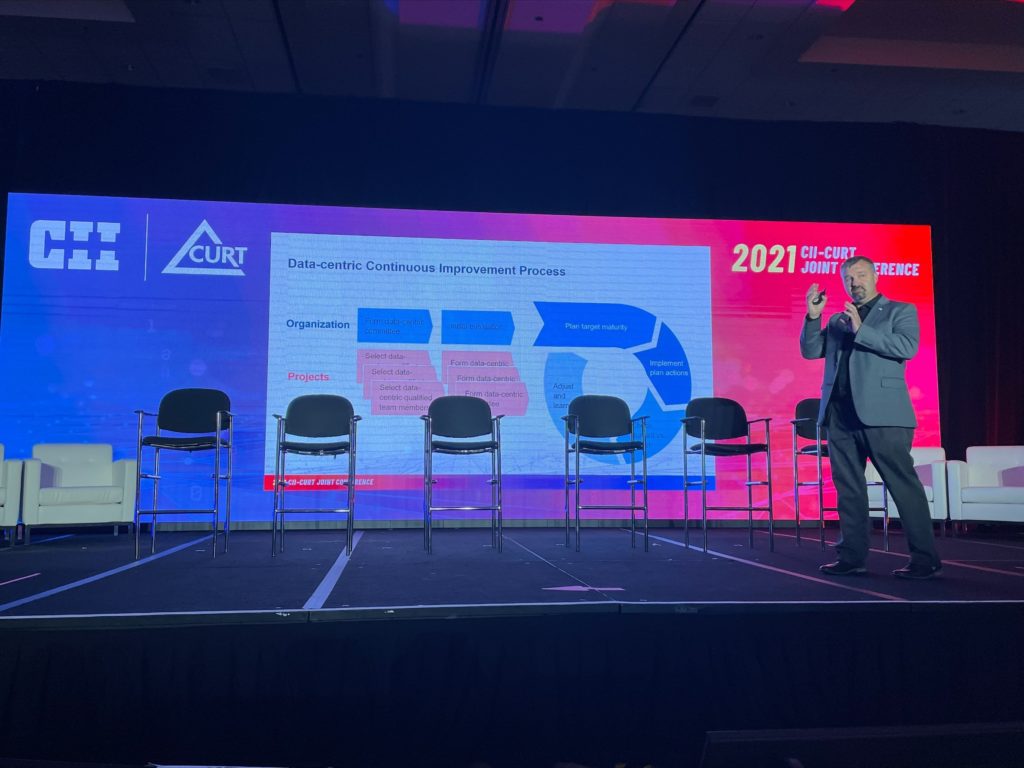19 Aug Day 2 CII-CURT 2021: The Construction Industry’s Past, Present, and Future
The Construction Industry Institute (CII) and the Construction Users Roundtable (CURT) welcomed members to their first-ever joint conference, “Resilience Through Innovation” in August.
If you haven’t already, check out our first blog on Day 1 of CII-CURT 2021.
The partnership between CII and CURT to deliver this event brought together two influential groups within the industry, bringing their perceptions on the past, present, and future of construction.
Here’s what they had to say on Day 2 of CII-CURT 2021:
ACHIEVING CAPITAL EFFICIENCY WITH MODULAR CHEMICAL PROCESS INTENSIFICATION
James O’Connor | CT Wells Professor of Project Management, University of Texas at Austin
Brian Paul | Professor of Mechanical, Industrial, and Manufacturing Engineering, Oregon State University
James and Brian joined the stage to discuss what modular chemical process intensification is and what it can do for construction. They open with the question, “What if your next project required a fraction of the plant volume at 87% less capital expenditures (CAPEX), 14% less operating expenses (OPEX), one-fifth the payback period, and almost twice the net present value (NPV)?”
THE PAST/ PRESENT: Over 35+ years, CII has conducted five studies on modularization, citing it as a best practice and breakthrough strategy. James and Brian define this strategy as exporting work hours from a conventional jobsite to a more preferred location, typically a fabrication shop.
They define chemical process intensification as any chemical engineering development that results in a smaller, cleaner, safer, and more energy efficient process or technology.
According to the speakers, there are a lot of proven benefits to chemical process intensification. In addition to shrinking chemical plants’ environmental footprint, the practice also:
– Reduces capital investment
– Improves process safety
– Lowers material costs
– Increases process flexibility and inventory reduction
– Increases attention to quality
Chemical process intensification can be divided into two areas: methods and equipment. Methods include multi-function processes, hybridized separations, and alternative energy sources, while equipment includes multi-function devices, heat and mass transfer, reactors, and separators and mixers.
One example of existing chemical process intensification is solar thermochemical processing, which is a compact technology that uses focused energy from the sun.
THE FUTURE: For those thinking about chemical process intensification, James and Brian offer some guiding principles:
– Maximize effectiveness of intramolecular and intermolecular events
– Give each molecule the same processing experience
– Optimize driving forces at all scales and maximize the specific service areas to which they apply
– Maximize synergistic effects from partial processes
Then, they describe the mutually beneficial linkages between modularization and chemical process intensification – one of which is mobility, meaning a company would enjoy geographically distributed customers/markets as well as energy sources/feedstocks.

DRIVING PROJECT CAPITAL EFFICIENCY: STRATEGIC ALIGNMENT FOR COMPETITIVE INVESTMENT DECISION AND EFFECTIVE PROJECT DELIVERY
Lokesh Sharma | Senior BIN Leader, Capital Projects, Chevron
Cathy Farina | Vice President, Operations, DyCat Solutions
Stephen Cabano | President, Pathfinder, LLC
Carlos Caldas | Professor, University of Texas at Austin
The team joined CII-CURT 2021 to share their research findings, which address opportunities to improve capital efficiency through competitive investment decisions and effective project delivery.
THE PRESENT: This project, which is still a work in progress, set out to accomplish three things:
– Define project capital efficiency
– Establish key project capital efficiency metrics to determine improvement areas
– Determine how to get alignment between the business side and the project side of the organization as well as among owners, contractors, and suppliers
The group defined project capital efficiency as “the measure of an organization’s ability to define, develop, and manage a competitive project that optimizes the return on investment over its lifecycle.” And to effectively accomplish this, they said their research shows alignment is key.
Project capital efficiency benefits all key stakeholders. Owners will see a higher return on investment, contractors will see better project execution, and suppliers/service providers will see more project opportunities.
For those looking to align all these stakeholders successfully, the group recommends engaging them early on at the start of the business planning phase.
Then, to fulfill the metrics portion of their research initiatives, the team started to develop a project capital efficiency scorecard to help companies pinpoint areas of improvement. They identified four areas to assess:
– Corporate and financial strategy
– Capital governance and processing
– Capital project expectations
– Project planning and delivery
THE FUTURE: While the scorecard isn’t yet complete, the group was able to outline how attendees will be able to use it once rolled out.
At the very beginning, representatives from both the business and project teams should be involved. They should analyze the management process and answer the scorecard’s questions. From those answers, the scorecard will provide a project capital efficiency score, which will capture project strengths as well as address gaps.
The research team is still finalizing the scorecard for deployment, but they encouraged attendees to participate in the testing phase of the scorecard in the meantime.

DRIVING VALUE: DATA AND THE POWER OF DISCIPLINED COLLABORATION
Robert Leicht | Associate Professor of Architecture Engineering, Pennsylvania State University
Mike Carrancho | Chief of Engineering and Design, Smithsonian Institution
Every project requires data from beginning to end (and beyond). So, Robert poses the question, “Why are project teams still working in a non-data-centric environment?”
Robert and Mike set out to answer this question in their research, finding barriers to becoming data-centric and providing a tool to help companies get on the right path.
THE PRESENT: According to the speakers, 95% of data captured in the construction industry goes unused. Robert and Mike administered a survey to determine why, and they found four main barriers to becoming data-centric:
– Interoperability between software
– Integration of multiple sources of data
– Cost to maintain an operational model of a facility
– Organizational cultural resistance to change
For those wanting to really overcome these barriers and become data-centric, the research team developed the Data-Centric Maturity Assessment that addresses all barriers, supports projects and organizations, uses objective indicators, and is easy to use.
THE FUTURE: Those interested can Google “Data Centric Maturity Assessment CII Resources” to access and download the Excel spreadsheet. From there, participants will answer all of the questions by ranking their company on a scale of 1 to 5.
According to Robert, 1 is a Model T car (uses no data) while 5 is a Tesla (maximizes full value out of data).
The speakers note that adopting a data-centric approach won’t fix issues overnight, but it’s a start. It’s really a continuous improvement process.
In the assessment, participants not only rank where they are currently, but they rank where they want to be in five years. Once target maturity is identified, participants should implement plan actions, adjust, learn, and then start the process all over again.
Robert stresses that keeping tabs on your company’s data-centric maturity not only provides incredible insights, but it also allows for increased transparency and growth.

A HUGE THANK YOU!
Access Sciences would like to thank all of CII-CURT 2021’s thought leaders! To learn more about our work in the construction industry, visit our Engineering & Construction webpage.




